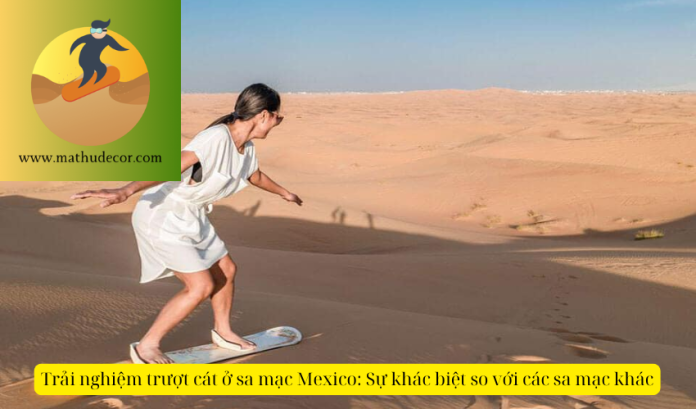“Sandboarding Experience in the Mexican Desert: How is it Different from Other Deserts?”
– Title: “How is sandboarding in the Mexican desert different from other deserts?”
– Short description: “Discover the uniqueness of sandboarding in the Mexican desert and compare it to experiences in other deserts through this article.”
I. Introduction to sandboarding in the Mexican desert
Mexico is a country located in North America, famous for its beautiful beaches and majestic natural landscapes. However, in addition to the wonderful beaches, Mexico also has impressive desert areas, including sandboarding – a popular and unique recreational activity.
1. Famous sand sliding location
– Altar Desert: Located in the state of Sonora, the Altar Desert is home to high and steep sand mountains, creating ideal conditions for sandboarding.
– Samalayuca Desert: Located in the state of Chihuahua, this desert has large and wide sand dunes, attracting many tourists to participate in sandboarding.
2. Sandboarding experience
When participating in sandboarding in the Mexican desert, visitors will experience the thrill of sliding down high sand mountains, as well as enjoy the wild and beautiful landscape of the desert. This activity is often organized under the guidance of safety experts, ensuring the safety of visitors when participating.
With unique and exciting experiences, sandboarding in the Mexican desert is an activity not to be missed for tourists who love adventure and challenge.
II. Diversity of sand in Mexican deserts
Sand diversity in the Sonora Desert
The Sonora Desert in Mexico is famous for its diversity of sand, from white sand to red sand and yellow sand. The sand in the Sonora Desert is made from many different types of rocks, creating a variety of unique colors. Additionally, the sand in the Sonora Desert is rich in minerals and fossils, making it a fascinating destination for geology enthusiasts.
Sand Diversity in the Chihuahuan Desert
The Chihuahuan Desert also has a unique diversity of sand. The sand here is often deep red in color and has large grain sizes, creating a strong and majestic feeling. In addition, the Chihuahuan Desert also contains many unique rock structures and geological formations, creating a wild and attractive landscape for visitors who want to explore natural beauty.
III. Popular sandboarding destinations in the Mexican desert
1. Dunes of Bilbao
Dunas de Bilbao is one of the most popular sandboarding destinations in the Mexican desert. It is a large sand dune area with beautiful scenery and many fun activities for visitors. Visitors can go sandboarding, go sand racing, or even participate in sand sports.
2. Samalayuca Dunes
Dunas de Samalayuca is a popular sandboarding destination in the Mexican desert. With its tall and vast dunes, it is the perfect place for those who love sand sports. Visitors can try sandboarding, sandhill climbing, or even take professional sandboarding lessons.
3. Yeso Dunes
Dunas de Yeso is another popular sandboarding destination in the Mexican desert. Located in the western part of Chihuahua, the area has fine white sand dunes that are perfect for sandboarding. Visitors can enjoy beautiful scenery and fun activities on the sand here.
IV. Differences in natural conditions and climate
1. Natural conditions
The physical conditions of deserts and sand dunes have notable differences. Deserts typically have high temperatures during the day and low temperatures at night, and are arid with very little rainfall. Vegetation in deserts is often sparse and can withstand the harsh conditions of arid environments. Sand dunes, on the other hand, are often devoid of vegetation and can have higher temperatures due to the reflection of sunlight on the sand.
2. Climate
Deserts and sand dunes can have different climatic conditions. For example, the Sahara Desert in Africa has a hot and dry climate, while the sand dunes in the Gobi Desert in Asia can have a colder climate due to their geographic location and the shape of their surroundings. Climate also affects the formation and development of sand dunes and deserts, creating unique geographical and climatic features for each region.
V. Experience of sandboarding in the Mexican desert
1. Preparation before sandboarding
Before participating in sandboarding in the Mexican desert, you need to prepare some necessary equipment such as sand goggles, masks, thick coats and protective shoes. In addition, provide enough drinking water and food to maintain health throughout the trip.
2. Choose a suitable sandboarding location
When you go to the Mexican desert, you need to learn about suitable and safe sandboarding locations. Look for dune fields or sand dunes that are steep and of the right size for safe and fun sandboarding.
3. How to sand slide safely
When sandboarding, always ensure safety by following safety rules such as wearing protective gear, not sandboarding alone, and following the instructor’s instructions. Be careful before starting each session and enjoy this exciting experience.
VI. Conclusion
Difference between desert and sand dune
The difference between a desert and a sand dune is clear. A desert is a large area of land that receives very little rainfall, typically less than 250 mm (10 inches) per year, while a sand dune is a landform that is deposited by the action of the wind, typically along a beach or in a desert. Deserts can contain a variety of landforms, including mountains, plateaus, and valleys, and can also contain sand dunes. Sand dunes can form when the wind blows sand into a sheltered area behind an obstacle.
Commonalities between deserts and sand dunes
Despite their obvious differences, deserts and sand dunes do have some things in common. They both involve dry, arid land lacking water and vegetation. Both deserts and sand dunes can be found in many areas of the world, and both can have a major impact on human and animal habitats.
Despite their differences, deserts and sand dunes both play an important role in understanding the Earth’s geography and natural environment. Understanding the differences and similarities between them will help us gain a more comprehensive view of these arid landscapes and unique topographic structures.
Sandboarding in the deserts of Mexico has its own unique characteristics compared to other deserts. Different terrains and weather conditions in each area create a unique sandboarding experience, attracting tourists to explore.




